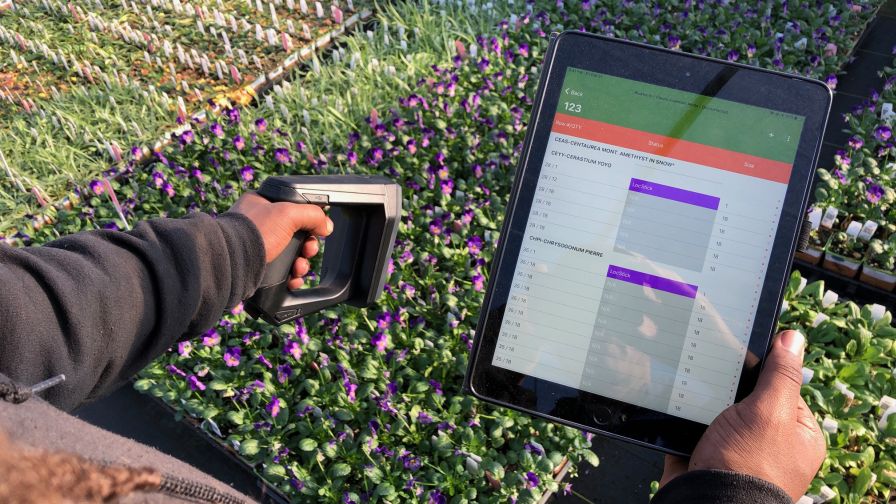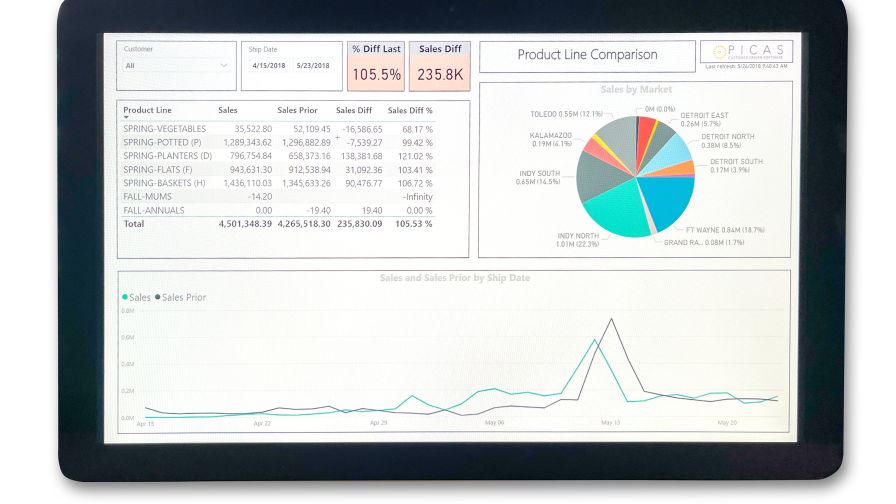How Software Can Help You Address Greenhouse Supply Chain Concerns

Real-time inventory management in the greenhouse can help growers navigate supply chain issues. Photo: Arbre Technologies
One of the most important benefits of proper software implementation is accuracy, and there’s perhaps no other metric today in which accuracy matters more than inventory management.
“Everything in today’s supply chain-driven market is interdependent, and if your inventory is inaccurate, it creates a domino effect,” says Matt Vollmer, CEO and President of Arbre Technologies, Inc. “The cost of that inaccuracy is higher than ever before, especially when you include the cost of labor, fuel, and shipping.”
Of course, software investment often comes down to return on investment, which Vollmer says starts with having a baseline of both your quantifiable (inputs, etc.) and those intangible costs, such as employee job satisfaction.
“Poor inventory or data management can lead to inefficiency, which has a negative effect on morale,” Vollmer says. “The decision then becomes, how can you implement a solution that allows you to track the same amount of data or more for less cost, less time, and with more accuracy and more timeliness so that you have the tools and the knowledge you need to make good decisions.”
Vollmer recommends starting by identifying your key metrics and what decisions you’re trying to make, and then work backwards from there. He also says growers don’t have to do it alone.
“It can be valuable to work with a third party that understands your problems and can help initiate the kind of changes that can help you make good, data-driven business decisions,” Vollmer says. “An outside vendor can also help set up definable metrics and work with you to achieve the results you want.”
Another concern growers have is manpower, Vollmer notes.
“A lot of our growers tell us they want to implement a solution, but they don’t have someone who can champion the project because they’re so short on bandwidth,” Vollmer says. “Some of them actually decide to go out and hire an inventory manager. I don’t think that’s always necessary, but everybody has a different business situation, so it’s something to think about.”
In the end, Vollmer says it all comes back to prioritization and knowing how to recognize if inventory is your company’s biggest challenge.
“It may seem obvious, but if inventory is indeed your biggest problem, then you should be carving out time to figure out how to solve it,” he says. “Horticulture businesses often have only a small window of opportunity to implement a solution, and if that window closes, you’re too late.”
Data Brings Realism
Good recordkeeping can help growers in planning, inventory utilization, future raw material ordering, and analyzing operations to make sure that profitability is achieved or to help identify areas or products of concern that need to be cut, according to John Beauford, President and Chief Technology Officer of Advanced Grower Solutions. He notes that recordkeeping also helps match the reality of your data with the reality of your operation.
“Good software and data help yield a more holistic picture for a grower’s operation,” Beauford says of the benefits of software. “Good software gives growers the ability to combine key data sets for more enlightened analysis and better decision-making. It can bring together the dissimilar sources and formats from payroll, production, inventory, costing, and sales analytics for example, to see the combined picture. It is the juxtaposition and combination of these dissimilar data sources that can yield new insights for operational improvements.”
To go from a collection of data to meaningful decisions requires both system support and grower involvement, Beauford says. Collected data must be clean and consistent, reflecting the reality of the transaction recorded. Collected data must be linked to other data sets and sources to build synthetic views. From the collected data standard reports, measures and metrics must be defined and calculated consistently.
“Appropriate tools can help automate the calculation and creation of derived data views to show key business metrics and historical period comparisons,” Beauford says. “Tools allowing structured drill down can also help yield additional correlative insights.”
Ideally, if a grower’s staff is spending time recreating the same reports weekly or daily or monthly, then they are probably missing insights,” Beauford warns.
“Use software to help automate the mundane yet important data manipulations and presentations and use the gained time to deep dive into cause-and-effect and design improvements or remediations,” he says.

Software companies such as The Picas Group can help growers identify pain points, track information from them, and use that information to make decisions on anything from sales to supply chain. Photo: The Picas Group
What Gets Measured Gets Improved
Collecting data is critical, and if you’re not collecting data, you need to start there so you have something to work with, says Ben Dill, Software Implementation Specialist at The Picas Group (formerly Innovative Software Solutions; learn more here). Then you can talk about analyzing it, putting it into a dashboard, and finding ways to take action from that data.
“One phrase I’ve heard a few times before is, what gets measured gets improved,” Dill says. “Once you have a measurement of something and are collecting data, you can now use that to improve something. We try to help growers identify those pain points, track information from them, and use that information to make decisions on anything from sales to supply chain.”
Improving efficiencies through software implementation can also extend to your entire team, including upper management.
“Everybody assumes that when you’re discussing efficiencies, you naturally default to manual labor,” says Andrew Stallmer, Brand Developer at The Picas Group. “But the reality is that if you’re in a higher-level position, you may have a certain number of tasks to do in a day, and if you feel like you don’t have the resources to get those tasks done, they’re just being pushed to the back burner and you’re getting them done when you can. For those times when you feel like you don’t have the resources to get things done, a lot of the time you probably do have the resources, they’re just not being allocated the right way. The right software can help you can take on some of those other tasks that you felt like you previously didn’t have the resources to handle yourself.”
Improving the Decision-Making Process
Mobile inventory control is foundational to success of any business, according to Aaron Allison, co-founder of SBI Software.
“It is the steering wheel for sales, and you have to make key crops visible at the right times to sell the product,” he says.
Allison says the focus at SBI Software is on simplifying growers’ jobs while using the software to make it easier to deal with turnover.
“Software is the key to driving the business, and making it easier for users on the ground is key to making the business grow,” Allison says.
When it comes to using data to make informed decisions, Allison says the key is to build a custom dashboard that shows top-level totals, while allowing users to drill down into crop details and transaction-level details.
“Create custom dashboards per department that drive decisions within those departments, and create daily and long-view dashboards to improve business visibility,” Allison says.










